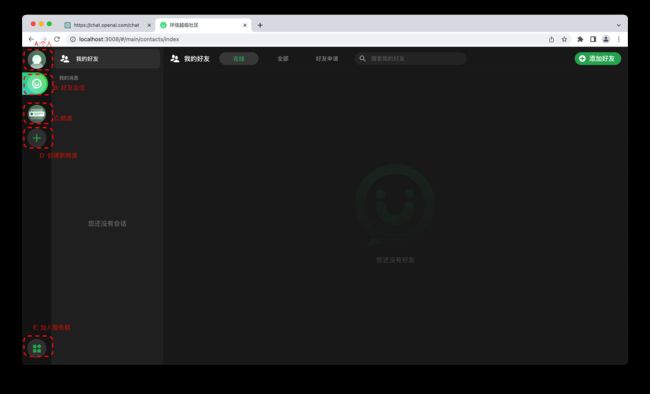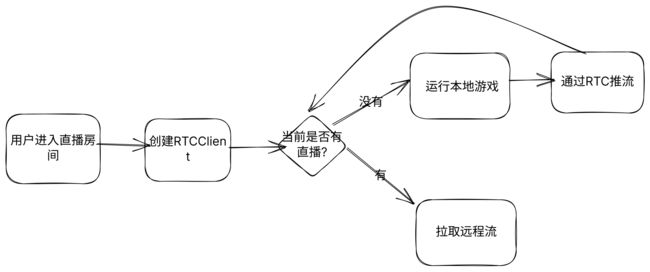实战:一天开发一款内置游戏直播的国产版Discord应用【附源码】
游戏直播是Discord产品的核心功能之一,本教程教大家如何1天内开发一款内置游戏直播的国产版Discord应用,用户不仅可以通过IM聊天,也可以进行语聊,看游戏直播,甚至自己进行游戏直播,无任何实时音视频底层技术的Web开发者同样适用,效果如下:
开整!
Step1 初始化
本项目基于环信超级社区的实例项目, 所以我们先从Circle-Demo-Web这个仓库开启做初始化
- 克隆项目
git clone https://github.com/easemob/Circle-Demo-Web.git - 安装依赖
npm install - 设置appKey
src/utils/WebIM.js中设置appKey,AppKey为环信后台项目对应的key,注册环信,https://console.easemob.com/user/register,登录console后台获取Appkey- appKey为环信后台项目对应的key, 如何开通可见开通配置环信即时通讯 IM 服务
- 运行项目
npm run start
与discord设计逻辑相似, 左边功能区有
- 个人信息页
- 好友会话页
- 当前加入的频道
- 创建新频道
- 加入服务器
超级社区的逻辑为
社区(Server)、频道(Channel) 和子区(Thread) 三层结构
社区为一个独立的结构, 不同社区直接相互隔离, 社区包含不同的频道, 代表了不同的话题, 用户在频道中聊天, 而针对一条单独信息产生的回复为子区.
我们本次的项目主要集中在频道部分, 需要加入一个服务器后, 创建一个测试社区, 保证你具有管理员权限.
Step2 协议设置
我们的目标是尽量利用现有api扩展功能, 有几个问题需要解决
- 如何区分普通频道和游戏频道?
- 如何区分当前频道是否有玩家直播, 如果有直播如何获取玩家信息, 第二玩家的状态?
- 多人聊天的状态?
如何区分普通频道和游戏频道
这里直接简单采用频道前缀做特殊区分, 创建频道前缀带video-的识别为游戏频道, 同时将渲染内容做替换
// views/Channel/index.js
const isVideoChannel = useMemo(() => {
return currentChannelInfo?.name?.startsWith("video-");
}, [currentChannelInfo]);
const renderTextChannel = () => {
// 原来的渲染逻辑
return (
<>
<MessageList
messageInfo={messageInfo}
channelId={channelId}
handleOperation={handleOperation}
className={s.messageWrap}
/>
<div className={s.iptWrap}>
<Input chatType={CHAT_TYPE.groupChat} fromId={channelId} />
</div>
</>
);
}
const renderStreamChannel = () => {
// 先填充一个占位符
return (
<>This is a Stream Channel<>
);
}
return (
...
<div className={s.contentWrap}>
{isVideoChannel ? renderStreamChannel() : renderTextChannel()}
</div>
...
);
如果需要区分图标, 可以搜索channelNameWrap, 分别在channelItem和Channel/components/Header中添加一个css类, 通过这个类设置图标图片
如何区分当前频道是否有玩家直播, 如果有直播如何获取玩家信息, 第二玩家的状态?
我们可以复用在频道中发送消息的机制, 直播开始, 结束都可以当做一条特殊的消息发送, 只不过这条消息不承载用户的信息, 而是表达用户上下播的行为
当然这个机制存在一定实时性的问题, 不过大致是可行的.
首先我们来看一条普通的消息是如何发送的
// components/input
//发消息
const sendMessage = useCallback(() => {
if (!text) return;
getTarget().then((target) => {
let msg = createMsg({
chatType,
type: "txt",
to: target,
msg: convertToMessage(ref.current.innerHTML),
isChatThread: props.isThread
});
setText("");
deliverMsg(msg).then(() => {
if (msg.isChatThread) {
setThreadMessage({
message: { ...msg, from: WebIM.conn.user },
fromId: target
});
} else {
insertChatMessage({
chatType,
fromId: target,
messageInfo: {
list: [{ ...msg, from: WebIM.conn.user }]
}
});
scrollBottom();
}
});
});
}, [text, props, getTarget, chatType, setThreadMessage, insertChatMessage]);
去除掉与输入框逻辑耦合的部分, 可以分为两步, createMsg创建消息, deliverMsg发送消息, 这两个功能都是环信SDK功能的封装, 经过查阅文档, 它支持发送自定义消息.
在utils中新建一个stream.js文件来封装直播的逻辑
// utils/stream.js
const sendStreamMessage = (content, channelId) => {
let msg = createMsg({
chatType: CHAT_TYPE.groupChat,
type: "custom",
to: channelId,
ext: {
type: "stream",
...content,
},
});
return deliverMsg(msg)
.then(() => {
console.log("发送成功");
})
.catch(console.error);
};
它接收content表示我们的额外信息, 用户名和上下播状态, channelId区分不同的channel, 对它的调用可以如下
// 定义在 utils/stream.js 中
const CMD_START_STREAM = "start";
const CMD_END_STREAM = "end";
// 上播
sendStreamMessage(
{
user: userInfo?.username,
status: CMD_START_STREAM,
},
channelId
);
// 下播
sendStreamMessage(
{
user: userInfo?.username,
status: CMD_END_STREAM,
},
channelId
);
第二玩家的状态可以类比第一个玩家用额外的自定义消息实现, 这里不做重复.
关于自定义消息, 原本它的作用是邀请用户加入频道, 你可以在components/CustomMsg中找到, 我们要额外识别一下直播消息(可以渲染在消息列表里, 也可以直接屏蔽掉).
// components/CustomMsg/index.js
const isStream = message?.ext?.type === "stream";
// 屏蔽
const renderStream = () => {
return (<>)
}
if (isStream) {
return renderStream();
} else {
...
}
多人聊天的状态?
我们引入声网RTC sdk, 每个进入直播房间的用户都对应维护一个声网客户端,
通过on事件感知远端视频/音频流.
根据文档 进行如下操作,
- 注册声网开发者, 并在后台创建一个测试项目
- 项目根目录创建
.env文件, 存放api token等信息
# channel, uid 暂时设置为固定
REACT_APP_AGORA_APPID = your app id
REACT_APP_AGORA_CHANNEL = test
REACT_APP_AGORA_TOKEN = your token
REACT_APP_AGORA_UID = 123xxx
- 添加声网sdk依赖
npm install agora-rtc-sdk-ng
我们在下一章中编写接入逻辑
声网RTC接入, 直播与语音实现
接入
在views/Channel/components文件夹下新增一个组件StreamHandler, 该组件为后续我们处理游戏房间的组件, 先初步编写声网接入逻辑
// views/Channel/components/StreamHandler/index.js
const options = {
appId:
process.env.REACT_APP_AGORA_APPID || "default id",
channel: process.env.REACT_APP_AGORA_CHANNEL || "test",
token:
process.env.REACT_APP_AGORA_TOKEN ||
"default token",
uid: process.env.REACT_APP_AGORA_UID || "default uid",
};
const StreamHandler = (props) => {
// 组件参数: 用户信息, 当前频道所有消息, 当前频道id, 是否开启本地语音
const { userInfo, messageInfo, channelId, enableLocalVoice = false } = props;
const [rtcClient, setRtcClient] = useState(null);
// 声网client连接完成
const [connectStatus, setConnectStatus] = useState(false);
// RTC相关逻辑
useEffect(() => {
AgoraRTC.setLogLevel(3);
const client = AgoraRTC.createClient({ mode: "rtc", codec: "vp8" });
// TODO: use right channel
client
.join(options.appId, options.channel, options.token, userInfo?.username)
.then(() => {
setConnectStatus(true);
console.log("[Stream] join channel success");
})
.catch((e) => {
console.log(e);
});
setRtcClient(client);
return () => {
// 销毁时, 自动退出RTC频道
client.leave();
setRtcClient(null);
};
}, []);
return (
<>
{!connectStatus && <Spin tip="Loading" size="large" />}
</>
);
}
// 我们需要全局状态中的userinfo, 映射一下到当前组件的props中
const mapStateToProps = ({ app }) => {
return {
userInfo: app.userInfo,
};
};
export default memo(connect(mapStateToProps)(StreamHandler));
然后回到Channel中, 在之前的renderStreamChannel函数中添加上StreamHandler组件
// view/Channel/index.js
const [enableVoice, setEnableVoice] = useState(false);
const toggleVoice = () => {
setEnableVoice((enable) => {
return !enable;
});
}
// 保留了输入窗口, 可以在它的菜单栏中添加游戏频道独有的一些逻辑,
// 这里我加入了开关本地语音的逻辑, 拓展Input的细节可以参照完整版代码
const renderStreamChannel = () => {
return (
<>
<div className={s.messageRowWrap}>
<StreamHandler messageInfo={messageInfo} channelId={channelId} enableLocalVoice={enableVoice} />
</div>
<div className={s.iptWrap}>
<Input chatType={CHAT_TYPE.groupChat} fromId={channelId} extraMenuItems={renderStreamMenu()} />
</div>
</>
);
}
const renderStreamMenu = () => {
return [
{
key: "voice",
label: (
<div
className="circleDropItem"
onClick={toggleVoice}
>
<Icon
name="person_wave_slash"
size="24px"
iconClass="circleDropMenuIcon"
/>
<span className="circleDropMenuOp">
{enableVoice ? "关闭语音" : "开启语音"}
</span>
</div>
),
}
];
}
此时我们创建一个video-开题的游戏频道, 应该可以看到命令行中输出了RTC连接成功信息. [Stream] join channel success
音视频推流
接下来我们继续做实质的RTC推流逻辑, 及用户上下播的入口. 但在那之前, 先简单过一下声网RTC中的一些概念.
参考以下步骤实现音视频通话的逻辑:
- 调用 createClient 方法创建
AgoraRTCClient对象。- 调用 join 方法加入一个 RTC 频道,你需要在该方法中传入 App ID 、用户 ID、Token、频道名称。
- 先调用 createMicrophoneAudioTrack 通过麦克风采集的音频创建本地音频轨道对象,调用 createCameraVideoTrack 通过摄像头采集的视频创建本地视频轨道对象;然后调用 publish 方法,将这些本地音视频轨道对象当作参数即可将音视频发布到频道中。
- 当一个远端用户加入频道并发布音视频轨道时:
- 监听 client.on(“user-published”) 事件。当 SDK 触发该事件时,在这个事件回调函数的参数中你可以获取远端用户
AgoraRTCRemoteUser对象 。- 调用 subscribe 方法订阅远端用户
AgoraRTCRemoteUser对象,获取远端用户的远端音频轨道RemoteAudioTrack和远端视频轨道RemoteVideoTrack对象。
(以上内容来自声网官方文档)
在上面的接入中, 我们已经完成了创建对象并加入频道两步.
在RTC中, 可以传输音频和视频信号, 由于单个RTC客户端要传输不同种类的数据, 每个单独的音视频源被分成不同的track(由于它们都是实时不断产生的, 我们称作流), 随后通过publish方法, 将我们本地的信号源交付给RTC客户端传输.
随后通过user-published事件的回调来在其他用户发布信号源时进行处理, 首先需要subscribe该用户来获取后续数据, 随后根据不同类型的信号流做处理.
离开时需要关闭本地当前的信号源, 并退出RTC客户端.
最后通过user-unpublished事件监听其他用户退出, 移除它们对应的信号流.
逻辑理清楚后代码就很容易看懂了
// views/Channel/components/StreamHandler/index.js
const StreamHandler = (props) => {
...
// 本地视频元素
const localVideoEle = useRef(null);
// 远程视频元素
const canvasEle = useRef(null);
const [rtcClient, setRtcClient] = useState(null);
const [connectStatus, setConnectStatus] = useState(false);
// 当前直播的用户
const [remoteUser, setRemoteUser] = useState(null);
// 远程音视频track
const [remoteVoices, setRemoteVoices] = useState([]);
const [remoteVideo, setRemoteVideo] = useState(null);
// RTC相关逻辑
useEffect(() => {
...
// client.join 后
// 监听新用户加入
client.on("user-published", async (user, mediaType) => {
// auto subscribe when users coming
await client.subscribe(user, mediaType);
console.log("[Stream] subscribe success on user ", user);
if (mediaType === "video") {
// 获取直播流
if (remoteUser && remoteUser.uid !== user.uid) {
// 只能有一个用户推视频流
console.error(
"already in a call, can not subscribe another user ",
user
);
return;
}
// 播放并记录下视频流
const remoteVideoTrack = user.videoTrack;
remoteVideoTrack.play(localVideoEle.current);
setRemoteVideo(remoteVideoTrack);
// can only have one remote video user
setRemoteUser(user);
}
if (mediaType === "audio") {
// 获取音频流
const remoteAudioTrack = user.audioTrack;
// 去重
if (remoteVoices.findIndex((item) => item.uid === user.uid) == -1) {
remoteAudioTrack.play();
// 添加到数组中
setRemoteVoices([
...remoteVoices,
{ audio: remoteAudioTrack, uid: user.uid },
]);
}
}
});
client.on("user-unpublished", (user) => {
// 用户离开, 去除流信息
console.log("[Stream] user-unpublished", user);
removeUserStream(user);
});
setRtcClient(client);
return () => {
client.leave();
setRtcClient(null);
};
}, []);
const removeUserStream = (user) => {
if (remoteUser && remoteUser.uid === user.uid) {
setRemoteUser(null);
setRemoteVideo(null);
}
setRemoteVoices(remoteVoices.filter((voice) => voice.uid !== user.uid));
};
}
接着我们根据之前提到的自定义消息判断当前在播状态, 以最后一条自定义消息为准.
// views/Channel/components/StreamHandler/index.js
const StreamHandler = (props) => {
const { userInfo, messageInfo, channelId, enableLocalVoice = false } = props;
// 第一条 stream 消息, 用于判断直播状态
const firstStreamMessage = useMemo(() => {
return messageInfo?.list?.find(
(item) => item.type === "custom" && item?.ext?.type === "stream"
);
}, [messageInfo]);
// 是否有直播
const hasRemoteStream =
firstStreamMessage?.ext?.status === CMD_START_STREAM &&
firstStreamMessage?.ext?.user !== userInfo?.username;
// 本地直播状态
const [localStreaming, setLocalStreaming] = useState(
firstStreamMessage?.ext?.status === CMD_START_STREAM &&
firstStreamMessage?.ext?.user === userInfo?.username
);
// 本地直播流状态
const toggleLocalGameStream = () => {
if (hasRemoteStream) {
return;
}
setLocalStreaming(!localStreaming);
};
// 根据直播状态选择渲染
return (
<>
{!connectStatus && <Spin tip="Loading" size="large" />}
{hasRemoteStream ? (
<RemoteStreamHandler
remoteUser={firstStreamMessage?.ext?.user}
localVideoRef={localVideoEle}
channelId={channelId}
userInfo={userInfo}
rtcClient={rtcClient}
/>
) : (
<LocalStreamHandler
localStreaming={localStreaming}
canvasRef={canvasEle}
toggleLocalGameStream={toggleLocalGameStream}
rtcClient={rtcClient}
userInfo={userInfo}
channelId={channelId}
/>
)}
</>
);
}
我们根据hasRemoteStream分成两种逻辑RemoteStreamHandler和LocalStreamHandler(可以先用div+文字的空实现占位), 首先我们来看本地游戏的逻辑
// view/Channel/components/StreamHandler/local_stream.js
const LocalStreamHandler = (props) => {
const {
toggleLocalGameStream,
canvasRef,
localStreaming,
rtcClient,
userInfo,
channelId,
} = props;
const [localVideoStream, setLocalVideoStream] = useState(false);
const localPlayerContainerRef = useRef(null);
// 开启本地视频流
useEffect(() => {
if (!localPlayerContainerRef.current) return;
const f = async () => {
// 暂时使用视频代替游戏流
let lgs = await AgoraRTC.createCameraVideoTrack();
lgs.play(localPlayerContainerRef.current);
setLocalGameStream(lgs);
}
f();
}, [localPlayerContainerRef])
const renderLocalStream = () => {
return (
<div style={{ height: "100%" }} ref={localPlayerContainerRef}>
</div>
)
}
// 控制上下播
const renderFloatButtons = () => {
return (
<FloatButton.Group
icon={<DesktopOutlined />}
trigger="click"
style={{ left: "380px" }}
>
<FloatButton
onClick={toggleLocalGameStream}
icon={
localStreaming ? <VideoCameraFilled /> : <VideoCameraOutlined />
}
tooltip={<div>{localStreaming ? "停止直播" : "开始直播"}</div>}
/>
</FloatButton.Group>
);
};
// 渲染: 悬浮窗和本地流
return (
<>
<div style={{ height: "100%" }}>
{renderFloatButtons()}
{renderLocalStream()}
</div>
</>
);
}
现在我们进入直播房间已经可以看到本地摄像头的内容了, 但我们还没有将视频流投放到RTC中, 且上播逻辑也没有处理
// view/Channel/components/StreamHandler/local_stream.js
useEffect(() => {
// 发布直播推流
if (!localStreaming || !rtcClient || !localVideoStream) {
return;
}
console.log("height", canvasRef.current.height);
console.log("publishing local stream", localVideoStream);
// 将流publish到rtc中
rtcClient.publish(localVideoStream).then(() => {
// 频道中发布一条消息, 表示开始直播
sendStreamMessage(
{
user: userInfo?.username,
status: CMD_START_STREAM,
},
channelId
).then(() => {
message.success({
content: "start streaming",
});
});
});
return () => {
// 用户退出的清理工作,
// unpublish流(远程), 停止播放流(本地), 发送直播关闭消息(频道)
if (localVideoStream) {
rtcClient.unpublish(localVideoStream);
localVideoStream.stop();
sendStreamMessage(
{
user: userInfo?.username,
status: CMD_END_STREAM,
},
channelId
);
message.info({
content: "stop streaming",
});
}
};
}, [rtcClient, localStreaming, canvasRef, userInfo, channelId, localVideoStream]);
为了测试直播效果, 我们需要登录第二个账号(使用浏览器的匿名/开其他的浏览器, 此时cookie没有共享, 可以多账号登录), 进入相同频道, 开启直播, 此时第一个账号应该会自动刷新状态(如果没有则手动切换一下频道), 进入到RemoteStreamHandler, 说明我们直播的逻辑已经完成.
本地语音的逻辑也是类似的, 这里就不再重复.
接下来是远程流的渲染逻辑, 它的逻辑相对简单, 观看者可以选择开始/停止观看直播流
// view/Channel/components/StreamHandler/remote_stream.js
const RemoteStreamHandler = (props) => {
const {
remoteUser,
localVideoRef,
toggleRemoteVideo,
channelId,
userInfo,
rtcClient,
} = props;
// 这里加一个强制t人的开关, 由于debug
const enableForceStop = true;
const forceStopStream = () => {
sendStreamMessage(
{
user: userInfo?.username,
status: CMD_END_STREAM,
},
channelId
);
};
const renderRemoteStream = () => {
return (
<div style={{ height: "100%" }}>
<div
id="remote-player"
style={{
width: "100%",
height: "90%",
border: "1px solid #fff",
}}
ref={localVideoRef}
/>
<div
style={{
display: "flex",
justifyContent: "center",
marginTop: "10px",
}}
>
<span style={{ color: "#0ECD0A" }}>{remoteUser}</span>
is playing{" "}
</div>
</div>
);
};
const renderFloatButtons = () => {
return (
<FloatButton.Group
icon={<DesktopOutlined />}
trigger="click"
style={{ left: "380px" }}
>
<FloatButton
onClick={toggleRemoteVideo}
icon={<VideoCameraAddOutlined />}
tooltip={<div>观看/停止观看直播</div>}
/>
{enableForceStop && (
<FloatButton
onClick={forceStopStream}
icon={<VideoCameraAddOutlined />}
tooltip={<div>强制停止直播</div>}
/>
)}
</FloatButton.Group>
);
};
return (
<>
<div style={{ height: "100%" }}>
{renderFloatButtons()}
{renderRemoteStream()}
</div>
</>
);
}
开关远程流的代码在StreamHander中, 作为参数传给RemoteStream
// views/Channel/components/StreamHandler/index.js
const toggleRemoteVideo = () => {
if (!hasRemoteStream) {
return;
}
console.log("[Stream] set remote video to ", !enableRemoteVideo);
// 当前是关闭状态,需要打开
// 开关远程音频的逻辑也与此类型.
if (enableRemoteVideo) {
remoteVideo?.stop();
} else {
remoteVideo?.play(localVideoEle.current);
}
setEnableRemoteVideo(!enableRemoteVideo);
};
ok, 现在我们已经实现了基于声网RTC, 在环信超级社区集成视频直播的功能.
直播替换为游戏流
接下来我们来将直播流升级一下, 替换成模拟器包, 为了方便测试, 我们直接使用打包好的版本(https://github.com/a71698422/web-0.1.1 ), pkg包解压后直接放置到项目根目录,
RustNESEmulator 是一个基于Rust语言的NES模拟器, 我们在web平台可以使用它编译好的wasm版本
并将mario.nes文件放到src/assets目录下, 这是初代马里奥游戏的ROM文件(你也可以使用你喜欢的nes游戏, 如果遇到问题, 欢迎到RustNESEmulator中提issue)
加入前端的模拟器适配代码
// views/Channel/components/StreamHandler
// from tetanes.
import * as wasm from "@/pkg";
class State {
constructor() {
this.sample_rate = 44100;
this.buffer_size = 1024;
this.nes = null;
this.animation_id = null;
this.empty_buffers = [];
this.audio_ctx = null;
this.gain_node = null;
this.next_start_time = 0;
this.last_tick = 0;
this.mute = false;
this.setup_audio();
console.log("[NES]: create state");
}
load_rom(rom) {
this.nes = wasm.WebNes.new(rom, "canvas", this.sample_rate);
this.run();
}
toggleMute() {
this.mute = !this.mute;
}
setup_audio() {
const AudioContext = window.AudioContext || window.webkitAudioContext;
if (!AudioContext) {
console.error("Browser does not support audio");
return;
}
this.audio_ctx = new AudioContext();
this.gain_node = this.audio_ctx.createGain();
this.gain_node.gain.setValueAtTime(1, 0);
}
run() {
const now = performance.now();
this.animation_id = requestAnimationFrame(this.run.bind(this));
if (now - this.last_tick > 16) {
this.nes.do_frame();
this.queue_audio();
this.last_tick = now;
}
}
get_audio_buffer() {
if (!this.audio_ctx) {
throw new Error("AudioContext not created");
}
if (this.empty_buffers.length) {
return this.empty_buffers.pop();
} else {
return this.audio_ctx.createBuffer(1, this.buffer_size, this.sample_rate);
}
}
queue_audio() {
if (!this.audio_ctx || !this.gain_node) {
throw new Error("Audio not set up correctly");
}
this.gain_node.gain.setValueAtTime(1, this.audio_ctx.currentTime);
const audioBuffer = this.get_audio_buffer();
this.nes.audio_callback(this.buffer_size, audioBuffer.getChannelData(0));
if (this.mute) {
return;
}
const source = this.audio_ctx.createBufferSource();
source.buffer = audioBuffer;
source.connect(this.gain_node).connect(this.audio_ctx.destination);
source.onended = () => {
this.empty_buffers.push(audioBuffer);
};
const latency = 0.032;
const audio_ctxTime = this.audio_ctx.currentTime + latency;
const start = Math.max(this.next_start_time, audio_ctxTime);
source.start(start);
this.next_start_time = start + this.buffer_size / this.sample_rate;
}
// ...
}
export default State;
改造local_stream
// view/Channel/components/StreamHandler/local_stream.js
import mario_url from "@/assets/mario.nes";
import * as wasm_emulator from "@/pkg";
import State from "./state";
const LocalStreamHandler = (props) => {
// 模拟器 state
const stateRef = useRef(new State());
// 注意要将原来的代码注释掉
/*
const [localVideoStream, setLocalVideoStream] = useState(false);
const localPlayerContainerRef = useRef(null);
// 开启本地视频流
useEffect(() => {
if (!localPlayerContainerRef.current) return;
const f = async () => {
// 暂时使用视频代替游戏流
let lgs = await AgoraRTC.createCameraVideoTrack();
lgs.play(localPlayerContainerRef.current);
setLocalGameStream(lgs);
}
f();
}, [localPlayerContainerRef])
// 推流的函数也暂时注释
useEffet...
*/
useEffect(() => {
// 本地游戏
if (!canvasRef) {
return;
}
// 开启键盘监听等全局事件
wasm_emulator.wasm_main();
fetch(mario_url, {
headers: { "Content-Type": "application/octet-stream" },
})
.then((response) => response.arrayBuffer())
.then((data) => {
let mario = new Uint8Array(data);
// 加载 rom数据
stateRef.current.load_rom(mario);
});
}, [canvasRef]);
// 更新本地流渲染
const renderLocalStream = () => {
return (
<div style={{ height: "100%" }}>
<canvas
id="canvas"
style={{ width: 600, height: 500 }}
width="600"
height="500"
ref={canvasRef}
/>
</div>
);
};
}
这一步完成后, 我们就可以在本地试玩马里奥游戏了, 键盘绑定为
A = J
B = K
Select = RShift
Start = Return
Up = W
Down = S
Left = A
Right = D
将推本地视频流改为游戏流
useEffect(() => {
// 发布直播推流
if (!localStreaming || !rtcClient) {
return;
}
// 只修改了流获取部分
// canvas的captureStream接口支持获取视频流
// 我们用这个视频流构造一个声网的自定义视频流
let stream = canvasRef.current.captureStream(30);
let localVideoStream = AgoraRTC.createCustomVideoTrack({
mediaStreamTrack: stream.getVideoTracks()[0],
});
console.log("height", canvasRef.current.height);
console.log("publishing local stream", localVideoStream);
rtcClient.publish(localVideoStream).then(() => {
sendStreamMessage(
{
user: userInfo?.username,
status: CMD_START_STREAM,
},
channelId
).then(() => {
message.success({
content: "start streaming",
});
});
});
return () => {
if (localVideoStream) {
rtcClient.unpublish(localVideoStream);
localVideoStream.stop();
sendStreamMessage(
{
user: userInfo?.username,
status: CMD_END_STREAM,
},
channelId
);
message.info({
content: "stop streaming",
});
}
};
}, [rtcClient, localStreaming, canvasRef, userInfo, channelId]);
至此该项目的完整流程就算结束啦,如果有哪些步骤细节不太明确, 可以参照完整版项目
环信超级社区项目
注册环信
模拟器直播项目github源码获取


